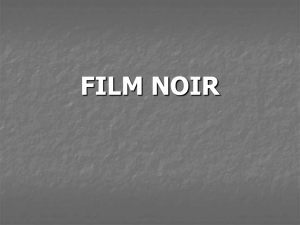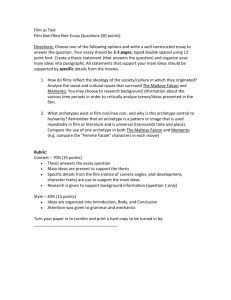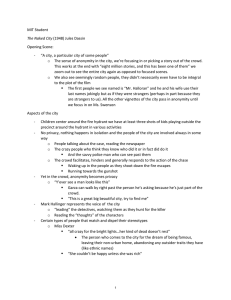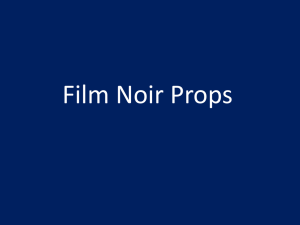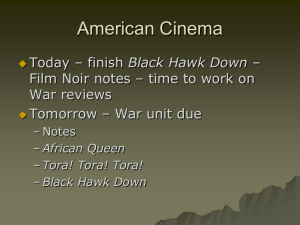From Riveter to Riveting:
advertisement
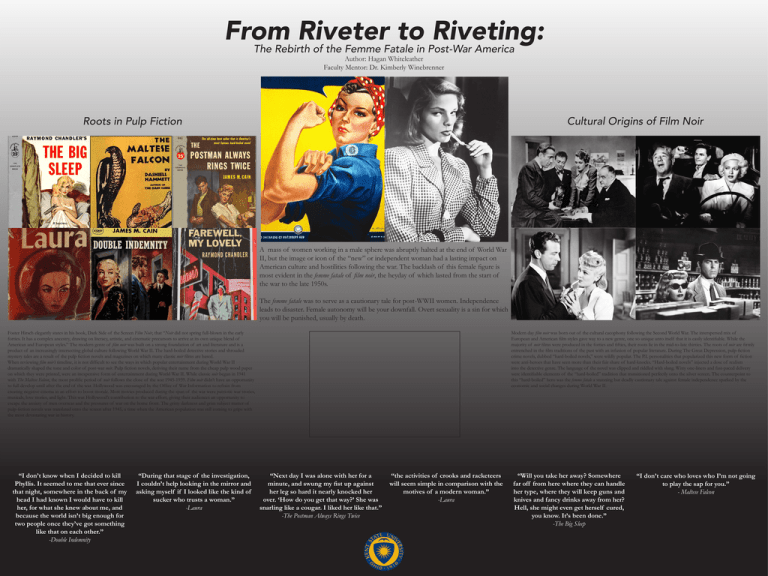
From Riveter to Riveting: The Rebirth of the Femme Fatale in Post-War America Author: Hagan Whiteleather Faculty Mentor: Dr. Kimberly Winebrenner Roots in Pulp Fiction Cultural Origins of Film Noir A mass of women working in a male sphere was abruptly halted at the end of World War II, but the image or icon of the “new” or independent woman had a lasting impact on American culture and hostilities following the war. The backlash of this female figure is most evident in the femme fatale of film noir, the heyday of which lasted from the start of the war to the late 1950s. The femme fatale was to serve as a cautionary tale for post-WWII women. Independence leads to disaster. Female autonomy will be your downfall. Overt sexuality is a sin for which you will be punished, usually by death. Foster Hirsch elegantly states in his book, Dark Side of the Screen Film Noir, that “Noir did not spring full-blown in the early forties. It has a complex ancestry, drawing on literacy, artistic, and cinematic precursors to arrive at its own unique blend of American and European styles.” The modern genre of film noir was built on a strong foundation of art and literature and is a product of an increasingly intersecting global culture following World War II. The hard-boiled detective stories and shrouded mystery tales are a result of the pulp fiction novels and magazines on which many classic noir films are based. When reviewing film noir’s timeline, it is not difficult to see the ways in which popular entertainment during World War II dramatically shaped the tone and color of post-war noir. Pulp fiction novels, deriving their name from the cheap pulp wood paper on which they were printed, were an inexpensive form of entertainment during World War II. While classic noir began in 1941 with The Maltese Falcon, the most prolific period of noir follows the close of the war 1945-1959. Film noir didn’t have an opportunity to full develop until after the end of the war. Hollywood was encouraged by the Office of War Information to refrain from creating negative cinema in an effort to boost morale. Most movies produced during the span of the war were patriotic war stories, musicals, love stories, and light. This was Hollywood’s contribution to the war effort, giving their audiences an opportunity to escape the anxiety of men overseas and the pressures of war on the home front. The gritty darkness and grim subject matter of pulp-fiction novels was translated onto the screen after 1945, a time when the American population was still coming to grips with the most devastating war in history. “I don’t know when I decided to kill Phyllis. It seemed to me that ever since that night, somewhere in the back of my head I had known I would have to kill her, for what she knew about me, and because the world isn’t big enough for two people once they’ve got something like that on each other.” -Double Indemnity “During that stage of the investigation, I couldn’t help looking in the mirror and asking myself if I looked like the kind of sucker who trusts a woman.” -Laura Modern day film noir was born out of the cultural cacophony following the Second World War. The interspersed mix of European and American film styles gave way to a new genre, one so unique unto itself that it is easily identifiable. While the majority of noir films were produced in the forties and fifties, their roots lie in the mid-to-late thirties. The roots of noir are firmly entrenched in the film traditions of the past with an infusion of popular literature. During The Great Depression, pulp-fiction crime novels, dubbed “hard-boiled novels,” were wildly popular. The P.I. personalities that popularized this new form of fiction were anti-heroes that have seen more than their fair share of hard-knocks. “Hard-boiled novels” injected a dose of realism into the detective genre. The language of the novel was clipped and riddled with slang. Witty one-liners and fast-paced delivery were identifiable elements of the “hard-boiled” tradition that transitioned perfectly onto the silver screen. The counterpoint to this “hard-boiled” hero was the femme fatale a stunning but deadly cautionary tale against female independence sparked by the economic and social changes during World War II. “Next day I was alone with her for a minute, and swung my fist up against her leg so hard it nearly knocked her over. ‘How do you get that way?’ She was snarling like a cougar. I liked her like that.” -The Postman Always Rings Twice “the activities of crooks and racketeers will seem simple in comparison with the motives of a modern woman.” -Laura “Will you take her away? Somewhere far off from here where they can handle her type, where they will keep guns and knives and fancy drinks away from her? Hell, she might even get herself cured, you know. It’s been done.” -The Big Sleep “I don’t care who loves who I’m not going to play the sap for you.” - Maltese Falcon
